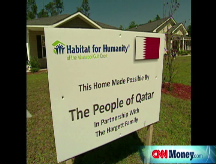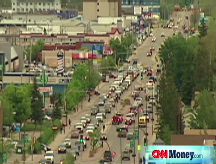The Big Easy picks up the pace
Census Bureau says New Orleans is the fastest-growing large city in the nation, recovering from being wiped out by Hurricane Katrina.
NEW YORK (CNNMoney.com) -- After being pummeled by Hurricane Katrina in 2005, New Orleans is showing signs of recovery - ranking as the fastest-growing large city in the nation, according to a government report released Thursday.
The Census Bureau said New Orleans' population rose 13.8%, to 239,124, in the year ended July 1, 2007. That was a faster growth rate than any other city with a population of 100,000 or more.
The figures can be taken with a grain of salt. Over the first seven years of this decade, "The Big Easy" experienced both the largest rate of loss and largest numerical decline, due primarily to the storm that devastated the city nearly three years ago.
The government said the city's population fell 50.7% since 2000, when it stood at 484,674.
The Census Bureau said the second fastest growing city in the nation was Victorville, Calif., whose population climbed 9.5% to 107,221. Located in Southern California, Victorville's population passed the 100,000 mark for the first time in 2007.
Big states dominate. California and Texas dominate the fastest growing cities, both in the recent annual data and in the data from 2000 through 2007.
California and Texas each placed five cities on the list of the 25 fastest-growing cities between 2006 and 2007, as well as on the list of the 25 biggest numerical gainers for the period.
Three cities in the Lone Star State made the fastest-growing top 10 list for the most recent year: McKinney, which was 3rd; Killeen, which was 6th; and Denton, which ranked 10th.
Other cities on the most recent list of the fastest growing cities were North Las Vegas, Nev., ranked 4th; Cary, N.C., ranked 5th; Port St. Lucie, Fla., ranked 7th; Gilbert, Ariz., ranked 8th; and Clarksville, Tenn., ranked 9th.
For the period from 2000 through 2007, McKinney, Texas, was the nation's fastest-growing city, its population more than doubling to 115,620.
Eight of the top 25 fastest-growing cities for the period from 2000 through 2007 were in California: Victorville, Elk Grove, Irvine, Roseville, Rancho Cucamonga, Moreno Valley, Bakersfield and Fontana.
By the numbers. While smaller Sun Belt cities top the fastest-growing list, the Census Bureau's top 10 list of numerical gainers was populated by larger cities.
In terms of sheer numbers, Houston led the nation's cities in numerical increase during the period. Houston added 38,932 residents in the year ended July 1, 2007 to reach 2.2 million.
Four of the top ten cities that showed the greatest numerical increases for the year were in Texas. In addition to Houston, San Antonio came in 3rd, Fort Worth was 4th and Austin was 8th.
Other cities in the top 10 of greatest numerical increases were Phoenix, which ranked 2nd, New Orleans, which was 5th, New York, which was 6th, Atlanta, 7th on the list, and two North Carolina cities, Charlotte in 9th place and Raleigh in 10th.
New York City was the largest numerical gainer between 2000 and 2007, adding 265,873 residents over the period. Houston added 233,876 people since the start of the millennium, in second place behind New York City.
Big Apple is still the biggest. The Big Apple continues to be the most populous city in the nation, with 8.3 million residents, according to the Census Bureau.
Los Angeles ranked second with 3.8 million residents. With 2.8 million, Chicago was third, followed by Houston and Phoenix, which each had 1.6 million. ![]()



